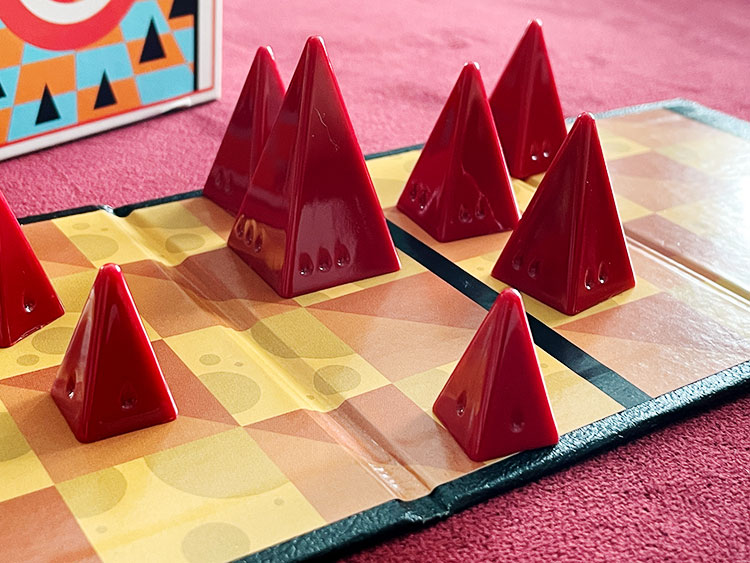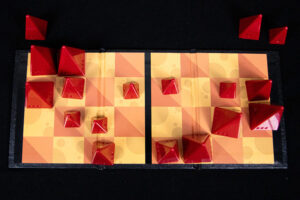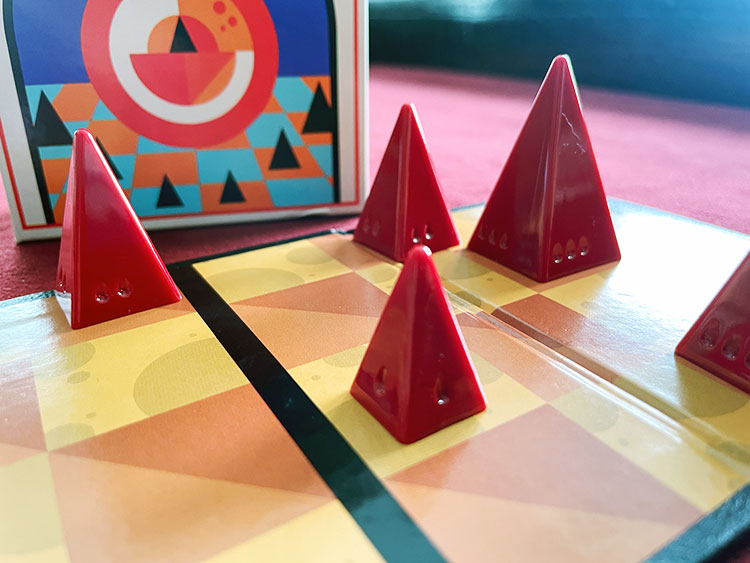 Mars is the new Zombies. Terraforming Mars. On Mars. First Martians. Even the OG, Mission Red Planet. But have you ever thought about how extraterrestrials would play Chess? I know you have, it is obviously one of humanity’s burning mysteries.
Mars is the new Zombies. Terraforming Mars. On Mars. First Martians. Even the OG, Mission Red Planet. But have you ever thought about how extraterrestrials would play Chess? I know you have, it is obviously one of humanity’s burning mysteries.
Well, today Looney Labs has returned from the red planet with their version of the classic abstract. Beware though, Martian Chess is nothing like the Chess you know and (perhaps) love.
Gameplay Overview:
The board is divided in half and each player controls a 4-by-4 section of squares. Unlike traditional Chess, or most abstract games for that matter, all the pieces are the same color. And because it’s Looney Labs, you can bet they are all pyramids. But they do come in three different sizes.
Rather than being able to move pieces of your color, you can instead only move pieces that are on your side of the board. The smallest pyramids—pawns—can only move one space at a time and must move diagonally. The medium-sized drones can move one or two spaces in any orthogonal direction. And the largest pieces, the queens, can move just like a queen in Chess, any number of spaces in any straight line.
If you move a piece over the center line and onto a piece owned by your opponent you capture it. Of course the piece you used to capture stays on the board and is now controlled by your opponent. The game ends as soon as any player’s side of the board is completely empty. You earn points for captured pieces (with the larger ones being worth more) and whoever has the most pieces wins.

Game Experience:
In a lot of abstract games, there is a clear delineation between yours and mine. The black pieces are mine, the white pieces are yours. We shall battle each other to the death. Well, not here on Mars. And that really starts to mess with your head.

Winning at Martian Chess is rarely about being up on material. The ultimate goal is points, but it comes down to carefully positioning pieces to be able to make captures. In doing so you have to be careful you aren’t setting your opponent up for taking a more valuable piece with the gift you just gave them. Pieces change ownership constantly.
There are even some thoughts of trying to position your powerful pieces on your opponent’s side of the board so you can capture them for big points. Obviously, in giving them away like that you’ll have fewer pieces to work with. But it can be really gratifying to see a spot where you can put a queen that will be stuck for a turn and you can capture it back quickly.
I am also always a sucker for games where the ending is within the control of the players. If you see yourself with a bit of a points advantage you’ll be encouraged to empty your side of the board as quickly as possible to bring things to an end. But you have to execute that plan carefully to not give away too many points to your opponent in the process. The game can bog down toward the end and has rules to declare a deadlock if pieces are just running around not getting captured, which can be a bit of a letdown.

Final Thoughts:
If you remember back a couple of years ago, almost all of the BGQ team was singing the praises of Shōbu, an elegant but interesting abstract game. Martian Chess belongs firmly in the same category. It feels familiar but also isn’t like anything you’ve played before. It is easy to learn and your first few plays may feel a bit random. It has enough depth that you’ll feel like you improve after each play. Martian Chess is a worthy addition to the collection of quick-playing abstract games.
Final Score: 4 Stars – A simple use of the Looney Labs pyramid system but it’s a thinky abstract that really feels unique.
 Hits:
Hits:
• Very easy to teach but the depth comes out in repeated plays.
• Ownership of pieces is based on position, not color. A weird and interesting spin on the normal formula.
Misses:
• End game can get into deadlocks pretty easily.






















